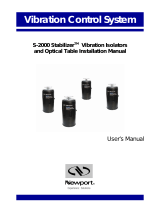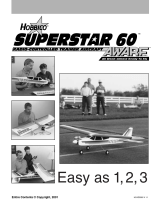Page is loading ...

Vibration Isolation Systems Setup Guide, April 2005
2
Optical Tops, Breadboards, and Supports
Accessories
Coupled Optical Tops
Introduction
TableTops can be coupled end-to-end or joined in L or T shape
configurations. They also can be configured with two working heights by
coupling tables with different thickness.
Figure 1 Typical coupled optical top
Caution Moving and coupling optical tops together should
be performed by professional riggers. The following
instructions are to assist professional machinery movers.
Safety
If you are uncertain of your ability to safely accomplish any aspect
of any work requirement
Stop W orkand Seek Assistance.
Plan your moving and assembly of equipment ahead of time.
Conduct a practice walk through prior to beginning any work.
Ensure all safety procedures for the proper use of hand tools and
power lifting equipment are used.
Never place anyone under a suspended load.
Contact the appropriate site safety authority for project approval
prior to commencing all work. If possible have a safety supervisor
present during work
Determine the number of people necessary to accomplish this task
safely; typically a minimum of three people.
Technical Manufacturing Corporation, Peabody, Massachusetts
Page 30

Vibration Isolation Systems Setup Guide, April 2005
2
Optical Tops, Breadboards, and Supports
Suggested Tools and Equipment
Gantry crane
(rated capacity greater than gross load)
Chain hoist and Gantry dolly
(rated capacity greater than gross load)
Assortment of cargo straps and attachment shackles
(recommend 2 each of 6 foot, 8 foot, 10 foot and 12 foot lengths)
Lifting hoist
(as required to assemble the Gantry crane at work site)
2 ratchet style 2 inch wide cargo straps 20 feet long
Assorted hand tools
(Snips, 24 inch Pry Bar, 3/8 inch Drive Ratchet and Socket Set,
Allen Wrench Set, Adjustable Wrench with 1-1/2 inch opening,#2
Phillips Screwdriver, #2 Slot Screwdriver)
Assorted blocking and shimming materials
(include 2 x 4’s, 4 x 4’s etc.)
3 hydraulic lift table carts (or suitable substitute)
(Confirm gross load requirements are met.) Carts used to position
tables for assembly. They must be able to provide up/down, left/right
and tilt adjustments necessary to align the tables for assembly.
2 Johnson Bars or Dollies (or other suitable equipment)
To move tables from unloading site to assembly area.
TMC provided assembly wrench, minimum 1, best 2
TMC provided slotted 0.030 inch thick x 2 inch wide x 7 inch long
backing shim
4 foot (minimum) level. 4 foot long (minimum) straight edge
7/16–20 tap and die
1-20 tap and die
Anti-seize compound (tube) and Q-tips
Lock-tight (tube)
Technical Manufacturing Corporation, Peabody, Massachusetts
Page 31

Vibration Isolation Systems Setup Guide, April 2005
2
Optical Tops, Breadboards, and Supports
Preparation
Unloading and uncrating optical tables and support posts.
When the equipment arrives the optical tops and associated crates
will require a staging area (loading dock) or other area in which to
unload the truck. This will often require a forklift.
The crates will most likely arrive laying flat on the truck. To
safely unload them, it will be necessary to lift them from the
bottom using a fork lift or similar device (pallet jack – dock
mules).
Uncrate the optical tops and support posts in accordance with the
un-packaging instructions on the crate.
Uncrate all isolator/post assemblies as required. Place in a safe
location with all other related parts packaged for later use.
Discard all unnecessary crating materials from the work area.
Lift and move the optical top to the installation location. It may be
necessary to lift and rotate the optical table to its side position
using a Gantry and hoist.
Assembly and setup
Step 1 Mark the floor with masking tape to outline the exact
placement for each optical table.
Identify table number 1 placement; the first and primary
reference table that the others will be aligned with.
Figure 2 Sample coupled table layout
Technical Manufacturing Corporation, Peabody, Massachusetts
Page 32

Vibration Isolation Systems Setup Guide, April 2005
2
Optical Tops, Breadboards, and Supports
Step 2 Assemble the isolators or posts in accordance with the
instructions provided for your model system.
Step 3 Place isolators/posts in the marked location for the installing
the primary optical top.
If multiple tops are being joined together, indented numeric
codes for the joining order are provided and must be
complied to.
Step 4 Lift the optical top and place it on the isolators/posts using
care to evenly balance the top on the Gantry crane.
Step 5 Carefully level and adjust the height position.
This optical top will become the reference to which all the
other optical tops will be positioned and joined.
Step 6 Apply a small amount of anti-seize compound to all the
female joiner plate
1-20
threads.
Step 7 Position the isolators/posts for the next optical top to be
joined to the reference top in its respective position but low
enough as to not interfere with the alignment of the top to
be joined.
Step 8 Lift and move the second top and position it just above the
isolators/posts as shown in figure 3 below using the Gantry.
Step 9 Position the second top so that it is within a few inches from
touching the “reference” optical top.
Step 10 Place the second top on the adjustable support stands or
jacks and align the dowels with the dowel holes in the face
of the joiner plates such that when appropriate pressure is
exerted to the second top towards the “reference” top, the
dowel pins will easily mate with the female dowel holes
referenced in figure 4 insert below.
This can be facilitated by placing a straight edge across the
two top surfaces as shown in figure 3 below.
Technical Manufacturing Corporation, Peabody, Massachusetts
Page 33

Vibration Isolation Systems Setup Guide, April 2005
2
Optical Tops, Breadboards, and Supports
4 foot straight edge
(2 foot min)
Joiner plate B
Joiner plate A
Optical Top
Tiebar
Isolator or support post
Floor
Figure 3 Joiner plates
Figure 4 Attaching Joiner plates together
Dowel hole
Dowel pin
Optical Top
Joiner plate threaded holes in
milled out slot area for .250 inch
thick wrench
Honeycomb connector with 7/16-20
Allen head socket cap screw
Joiner plate-A Joiner plate-B
Tops coupled together
Technical Manufacturing Corporation, Peabody, Massachusetts
Page 34

Vibration Isolation Systems Setup Guide, April 2005
2
Optical Tops, Breadboards, and Supports
The second top must be level and co-planar with respect to
the “reference” top to facilitate proper joining. Continuously
check and adjust as required.
You can continue using the Gantry crane and straps for this
procedure with the optical top suspended in the air, but it
will be more difficult to maintain top alignment during
leveling and co-planar adjust necessary to engage the dowel
pins.
Step 11 Place a ratchet strap of appropriate length around the girth
of the two optical tops to be joined.
Step 12 Slowly ratchet the two tops together while ensuring that the
tops remain co-planar and level with respect to one another
as referenced in figure 3 above.
The dowel pins and holes referenced in figure 4 insert will
mate as tops come together.
Ensure that the honeycomb connectors (nuts) do not jam
against the corresponding joiner plate threaded holes.
Step 13 Ensure you can freely turn ALL honeycomb connectors
with your fingers. Then engage the first thread into the
threaded hole in joiner plate-A as reference in figure below.
Note
Once you have verified that all honeycomb
connectors are free to turn, it is recommended that you use
the supplied
0.030 inch
shim tool and wrench referenced in
figure 5 & 6 below to start the first thread of each
honeycomb connector. Using the shim will insure that all
connectors start straight.
Technical Manufacturing Corporation, Peabody, Massachusetts
Page 35

Vibration Isolation Systems Setup Guide, April 2005
2
Optical Tops, Breadboards, and Supports
.030 inch thick shim
Slotted shim,
2 inches square, .030 inches thick,
5/8 inch cut-out slot
Joiner plate-B
Figure 5 Honeycomb Connectors
Figure 6 Wrench tightening honeycomb connector
Step 14 Once all honeycomb connectors are engaged into joiner
plate-B increase the pressure on the ratchet strap as required
to facilitate tightening the honeycomb connectors.
1/3 turn
(120 degrees)
1/4 inch thick wrench
Honeycomb
connector
Milled out area in
joiner plate-A
7/16 inch Allen head
socket cap screw
Milled out area for
1/4 inch thick wrench
Ensure a .030 inch gap
Honeycomb threaded connector
(turns freely over cap screw head)
Joiner plate-A
Technical Manufacturing Corporation, Peabody, Massachusetts
Page 36

Vibration Isolation Systems Setup Guide, April 2005
2
Optical Tops, Breadboards, and Supports
Step 15 Using the shim tool and wrench shown in figure above, start
from the left side of the optical top and turn each
honeycomb connector in consecutive order only
1/3
turn or
2
flats at a time, moving in a clockwise direction completely
around the top.
.
Important
If one or more of the honeycomb
connectors becomes jammed, then stop and
loosen all connectors and start over.
If at any time a connector is damaged, then all
connectors must be loosened, the two tops
pulled apart and the damaged components
replaced.
See troubleshooting instructions at the end of
this procedure.
Step 16 Torque each honeycomb connector to approximately
20 foot-pounds
.
This equates to approximately
40 pounds
. of force applied
to a
6 inch
wrench handle.
Step 17 Raise the isolators/posts such that they provide a coplanar
support across the second optical top.
Rigid support posts: If non-isolating posts were installed
adjust the top support foot on each post until the both tops
are level. This requires a #2 Phillips screw driver and
adjustable wrench.
Isolator posts: If isolation posts were installed complete
their installation using the TMC instruction sheets provided.
Step 18 Repeat above steps to join additional optical tops as
appropriate.
Technical Manufacturing Corporation, Peabody, Massachusetts
Page 37

Vibration Isolation Systems Setup Guide, April 2005
2
Optical Tops, Breadboards, and Supports
Step 19 Once tops have been coupled together, apply provided
stainless steel strip of tape down on the joiner plate areas
between the joined optical tops.
First peel away the backing tape and apply sticky side
down. This provides a finished surface across the joined
optical tops.
Joined optical tops
Milled out area in joiner
plate-A for wrench to tighten
honeycomb connectors
Area for applying stainless
steel strip of tape
Figure 7 Joiner plate area between optical tops
Technical Manufacturing Corporation, Peabody, Massachusetts
Page 38

Vibration Isolation Systems Setup Guide, April 2005
2
Optical Tops, Breadboards, and Supports
Troubleshooting
If a connector becomes jammed during the installation process, then
proceed as follows.
Back off all connectors in the opposite direction from installation
using the same procedure.
Once the optical tops are separated, remove and discard the
damaged
7/16–20
cap screws.
Discard any honeycomb connectors that have been deformed.
Re-tap the
7/16 inch
and
1-20
holes as necessary.
Apply lock-tight to the
7/16 inch
cap screws.
Install the new screws and honeycomb connectors.
Ensure that a
0.030 inch
clearance is provided between the joiner
plate and
1-20
screw shoulder. Compare to an existing non-
damaged honeycomb connector if in doubt.
Once repair is completed, begin installation procedure again.
Technical Manufacturing Corporation, Peabody, Massachusetts
Page 39
/



